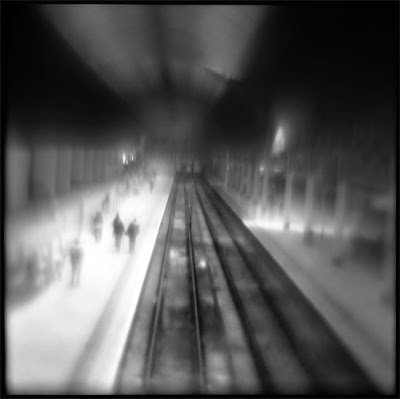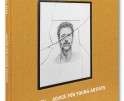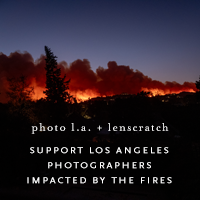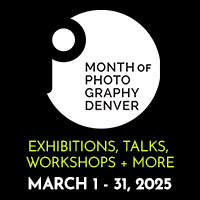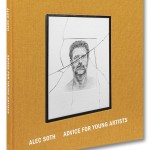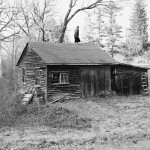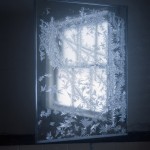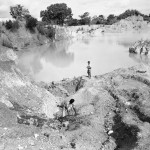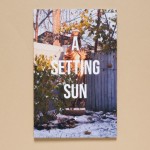Success Stories: Susan Burnstine
Today’s post is especially meaningful as I am celebrating a significant marker in a photographer’s journey. And it’s not just any photographer, but a long time friend who has worked hard to create a career of focused intention, unusual creativity, good will, and professionalism. Susan Burnstine has published her first monograph, Within Shadows, through Charta, that will be hitting the bookstores this fall and that is, indeed, a success story. The book is available for order on Susan’s site, and I strongly recommend getting your orders in early! In addition, Susan is offering “a print and book” set at a very reasonable price.
A Chicago native, now living in Los Angeles, Susan brings a a whole set of life experiences to her photography. She is an observer and interpreter of our place in the world, a writer, with a regular column in Black & White Photography (UK), animal lover and advocate, a juror for national competitions, and a photographer with an international roster of seven galleries with exhibitions around the world.
Susan portrays her dream-like visions entirely in-camera, rather than with post-processing manipulations. To achieve this, she created twenty-one hand-made film cameras and lenses that are frequently unpredictable and technically challenging. The cameras are primarily made out of plastic, vintage camera parts and random household objects and the single element lenses are molded out of plastic and rubber. Learning to overcome their extensive limitations has her to rely on instinct and intuition… the same tools that are key when trusting in the unseen.
Congratulations on Within Shadows! How exciting it must be to physically hold the book for the first time! Tell us more….
Thank you, Aline. Means a lot coming from you, since you’ve been on this ride with me from the beginning.
When my five advance copies arrived from Italy, I tore the box open as fast as I could. But as I took the book out of the shrink wrap…everything slowed down, almost as if the world was in slow motion but my head was spinning at 90 miles an hour. I felt strangely numb as I held this two-pound monochrome baby in my hands. I couldn’t grasp a single thought or conceive of what to do next. And then it happened. I found a printing flaw on one page and the air went out of the room. I was like a deer in the headlights for the first 24 hours and didn’t show the book to anyone. The next day, I worked the courage up to look at another copy of the book and found that the flaw was isolated to three of the five copies. Charta checked their stock and confirmed it was an isolated flaw and that was a tremendous relief, so I stated breathing again. The next day I arrived at Photolucida and anxiously presented the book to a few trusted friends. They were generous with their comments, so I started to get over my initial uncomfortable new parent phase and settle into the book. After a few days of reviews at Photolucida, positive response was consistent and my post-partum photo book blues evaporated.
Can you give us some insight into the process of getting a book published?
There’s so many way to get a book published, but I guess it starts with finding a publisher that understands your vision and has a history of creating books that are in line with how you imagine your book. My book packaging agent, Alan Rapp, sent a select number of proposals out to companies he felt might be right for my work, including Charta. I had seen some of their books prior and was impressed by the printing quality so it made sense for me to go with them since my work is not easy to reproduce in print. After we agreed on terms and dates, we entered the design process. I had a pretty clear vision of what I wanted, and Charta respected that so I was able to get 95% of what I wanted in the design process. Since I had previously designed the cover on the book for a catalog that was the easiest part of the process. The interior pages emerged in a more panicked, immediate manner. I didn’t realize I would be responsible for sequencing and found this out with a deadline of a week to get it done, I called my friend Dave Anderson in a panic and he generously helped with a large part of the sequencing as did my friend Brad Moore, my brother Keith and few other friends making it a group effort. The design phase lasted for three very stressful few weeks but in the end, I was very happy with the outcome of the book.
Were you able to include all the images that you wanted or are there some orphans that wish they could be part of that family?
I included almost all the images I had hoped would be in the book. But I regret that I did not include an image entitled Reflect. As we completed the design of the book, I was informed that the UK pop band The Guillemotts wanted to use seven of my images for their new album and Reflect was going to be the cover. Dave Anderson had suggested using that image in the book, but I shrugged it off since it had not gained popularity or become a big seller in the past. Which just goes to show, always listen to Dave. But perhaps the lack of inclusion made that image a bit more special in the end.
Do you think that having a monograph is a set point in a photographers career? Does it give you a tangible feeling of achievement?
I’ve been told that having a monograph reflects all those things. But as I write this, the book has yet to be released. So honestly, I can only tell you that’s what everyone else says. I guess history will tell if the book changes the course of my career in anyway.
Do I have a tangible feeling of achievement? I’m the sort of person who never revels in an accomplishment since my mind is always on the next image or project. I’d be afraid to say it was an achievement until I looked back to this moment ten years in the future.

Your new work (which I love), The Absence of Being, feels a bit more specific–dreamy, but more recognizable. Are you approaching your new work differently?
Ah, bless you Aline. You just made my week. Thank you.
Absence of Being is coming from a very different place than Within Shadows. My father suffered a massive stroke in June of 2009 and the event changed my life forever. I could no longer visualize in an intangible manner since the man who shaped me lay paralyzed in a bed, courageously fighting for his life and clinging to the blind hope he’d beat the odds and survive. When he died, my dreams changed and the nightmares/terrors that haunted me for years (the impetus behind Within Shadows) returned full force, but they expressed very different themes and struggles than the dreams that haunted me prior. The series explores how the past remains with us all, if only in shadows. The images capture fleeting memories, spotted from the corner of an eye that vanish the moment we really look. And yet they remain, for the imprints remains with us even after someone or something is long gone. I am also shooting this work from an entirely different perspective, much of which is from high above and further away from human subjects than previous work.
Do you ever think about working in color, or are you committed to Black and White?
I’m open to any and all possibilities.
I actually shot the homemade work in color early on. But the dream work only made sense to me in black and white. I think that’s because I dream mostly in black and white so it feels authentic to my perspective. I should add that I spent most of my childhood in a black and white darkroom so it’s how I tend to “see” my fine art work. That said, I wouldn’t be surprised if I moved onto color in the not so distant future.
Any chance you will move to the dark side and start shooting digital for your fine art work? Do you think it matters to collectors?
I shoot digital for commercial work, but it doesn’t speak to me for my personal work. A significant part of my creative process is based in hands on, homemade approaches. But if I were being honest, I frequently have digital camera envy since it would be great to know how an image turned out before leaving a location, especially when I’m shooting in another city. But when it comes down to it, I thrive on film and all the magic that comes with the process. So I can only hope film sticks around indefinitely. As far as collector’s thoughts, I can’t say for sure since I’m just an artist. My only basis for a response would be reporting what I see collectors buying at art fairs and in galleries. It seems we are in a transitional time where many collectors don’t care as much about how an image was shot, but they still care a great deal about the print and archival quality.
What advice can you give emerging photographers, especially on presentation, on networking, on consistently producing excellent work?
First, do the work. Don’t obsess about the end result. Focus on what you are trying to convey through the lens, enjoy the process and embrace your mistakes. I would not have happened upon my process and style if it weren’t for making a lot of mistakes that brought me to what I am doing today. And once you have completed that body of work and feel confident with the results, portfolio reviews can be highly valuable tools for getting the work seen by decision makers, understanding it’s strengths and weaknesses and networking with other photographers. I’ve met a number of good friends through portfolio reviews over the years. Presentation is very important, but making work you believe in is the key.
What opportunity took your career to the next level?
Next level meaning galleries? After I completed On Waking Dreams, the first of what became three chapters for Within Shadows, I had a gut feeling to leave a portfolio of the work in my car during Photo LA 2007. A chance meeting at the fair with photographer Dave Anderson led to my representation with Susan Spiritus that day. It was also the beginning of my friendship with Dave, whom I consider one of my most trusted advisors and photo pals. I was crazy lucky because I did what you are told never to do; show your work to a gallery at Photo LA. Or should I say that Dave did what you are told never to do as he was kind enough to show my work to Susan Spiritus, which in effect, got the entire ball rolling for me.
Has social networking changed how you promote and market your work?
The only social networking I do these days is facebook. I’m not on the tweet boat yet. Just can’t grasp that one yet. I have a facebook fan page I post at regularly and it’s a wonderful marketing tool. I also send out periodic newsletters and they have proven to be very effective.
Do you ever have periods of self-doubt and feel creatively unmotivated?
Self-doubt is my middle name. I think the nature of being an artist is to continually question the world around you. But with that, comes the incessant questioning of yourself, your purpose and your art.
I am always driven to photograph, but I do hit dry spells since the work is so intensely personal. I have to reach deep down inside to make these images and sometimes that’s not easy. Dry spells are always related to something difficult happening in my life and that can stop me from feeling free to create my work. For example, when my dad became ill in June 2009, I tried to shoot, but everything I photographed was amiss. Life was a constant challenge and I wasn’t connecting with the deepest part of me, so the work wasn’t in sync on many levels. My perspective was also changing so attempting to shoot what had worked in the past, wasn’t working in the present. I didn’t really shoot anything of worth until five months after my dad’s death. During a trip to New York City in April 2010, I photographed the image As Above So Below and Impasse, which subsequently, allowed me to understand what the new work was to become. I traveled to New York City a number of times that year and found that being there was the creative spark the work needed since it allowed me to convey my feelings of feeling displaced and searching for roots through imprints in an organic manner. I should add that during the period that I wasn’t shooting, I constantly questioned if I’d be able to shoot personal work again. But I just kept shooting. Fortunately, Absence of Being came to be.
And finally, what would be your perfect day?
Life to me is about finding the beauty in imperfections. That sounds like a cheesy greeting card, but I really mean it. And I think that is conveyed in my artistic process which relies on imperfections. But in life…Heck, I’m happy for a good laugh, a cloudy shooting day in LA, some steamy Geno’s East pizza (I just teleported myself home to Chicago for that portion of my perfect day), seeing a potentially great image for the first time on the negative that I shot that morning and a late afternoon hike with my dog Blue. I should add that Blue will be twenty in next month, so I carry her on hikes now. But just the memory of 18 years of hiking with her is perfection to me.
Posts on Lenscratch may not be reproduced without the permission of the Lenscratch staff and the photographer.
Recommended
-
Alec Soth: Advice for Young ArtistsMarch 20th, 2025
-
Gina Costa & Janet Sternburg explore memory, objects, & the Los Angeles FiresMarch 1st, 2025
-
Interview with Dylan Hausthor: What the Rain Might BringDecember 23rd, 2024
-
Photography Educator: Eliot DudikDecember 13th, 2024
-
Jordan Eagles in Conversation with Douglas BreaultDecember 2nd, 2024


